NURS434: Diabetes and South Asian Refugees in Toronto: A Health Report
VerifiedAdded on 2022/08/27
|10
|2481
|24
Report
AI Summary
This report examines the prevalence of type 2 diabetes among South Asian immigrants in Toronto, focusing on community health nursing and public health principles. The study identifies the target population and highlights the role of nurses in assessing risks, providing health education, and implementing health promotion programs. Key concepts discussed include social determinants of health (socioeconomic status, lifestyle changes, stress, and language barriers), risk factors (cardiovascular issues, neuropathy, kidney damage, depression), and health promotion programs (stress management, healthy eating, and lifestyle modification). The report emphasizes the importance of ethnic-language-specific diabetes education, physical activity, weight control, regular exercise, and medication adherence in preventing and managing diabetes. The role of nurses in providing treatment, education, monitoring, and emotional support is also discussed, emphasizing the need for evidence-based practice and 24-hour patient care to improve outcomes for South Asian refugees with diabetes.
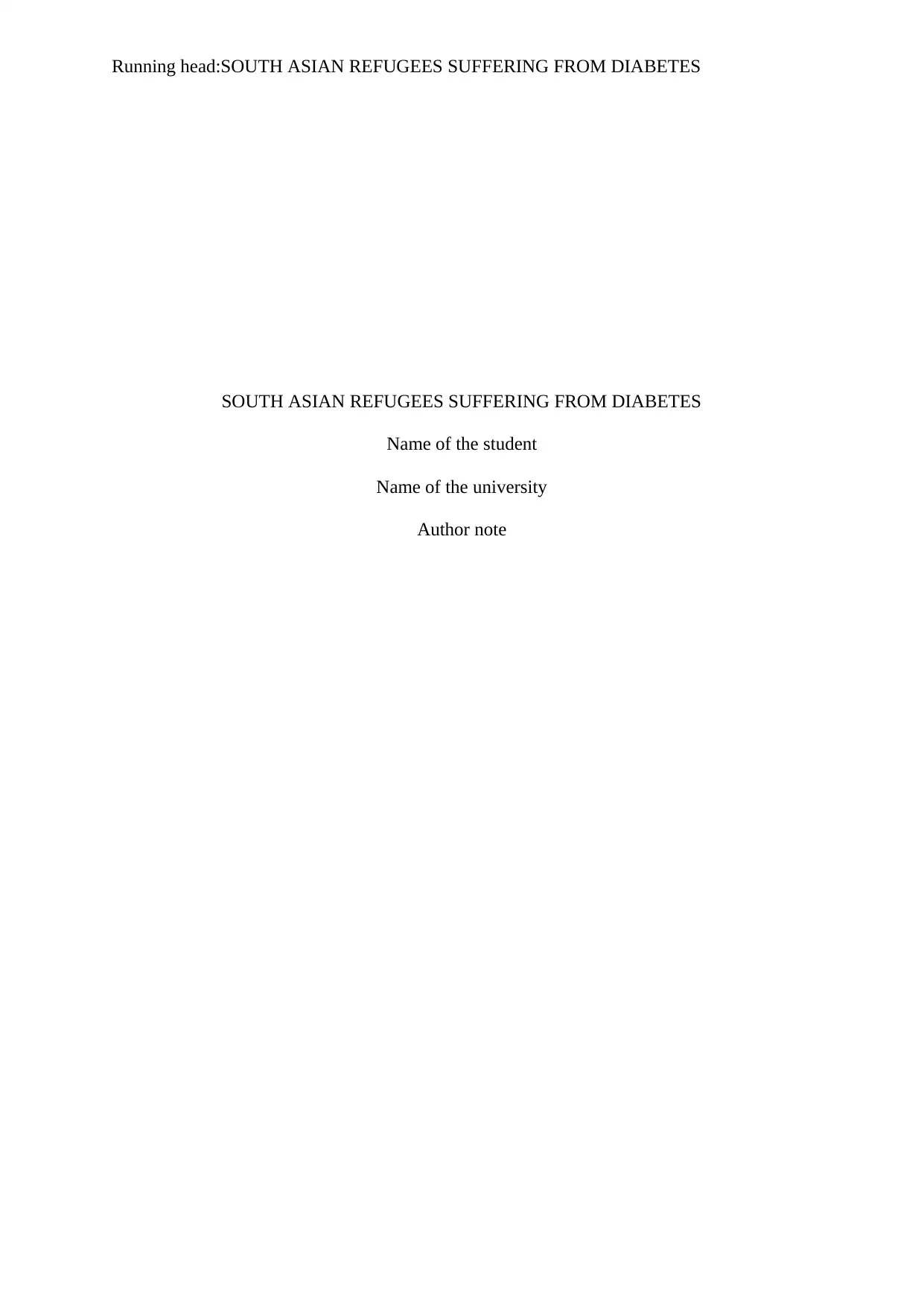
Running head:SOUTH ASIAN REFUGEES SUFFERING FROM DIABETES
SOUTH ASIAN REFUGEES SUFFERING FROM DIABETES
Name of the student
Name of the university
Author note
SOUTH ASIAN REFUGEES SUFFERING FROM DIABETES
Name of the student
Name of the university
Author note
Paraphrase This Document
Need a fresh take? Get an instant paraphrase of this document with our AI Paraphraser
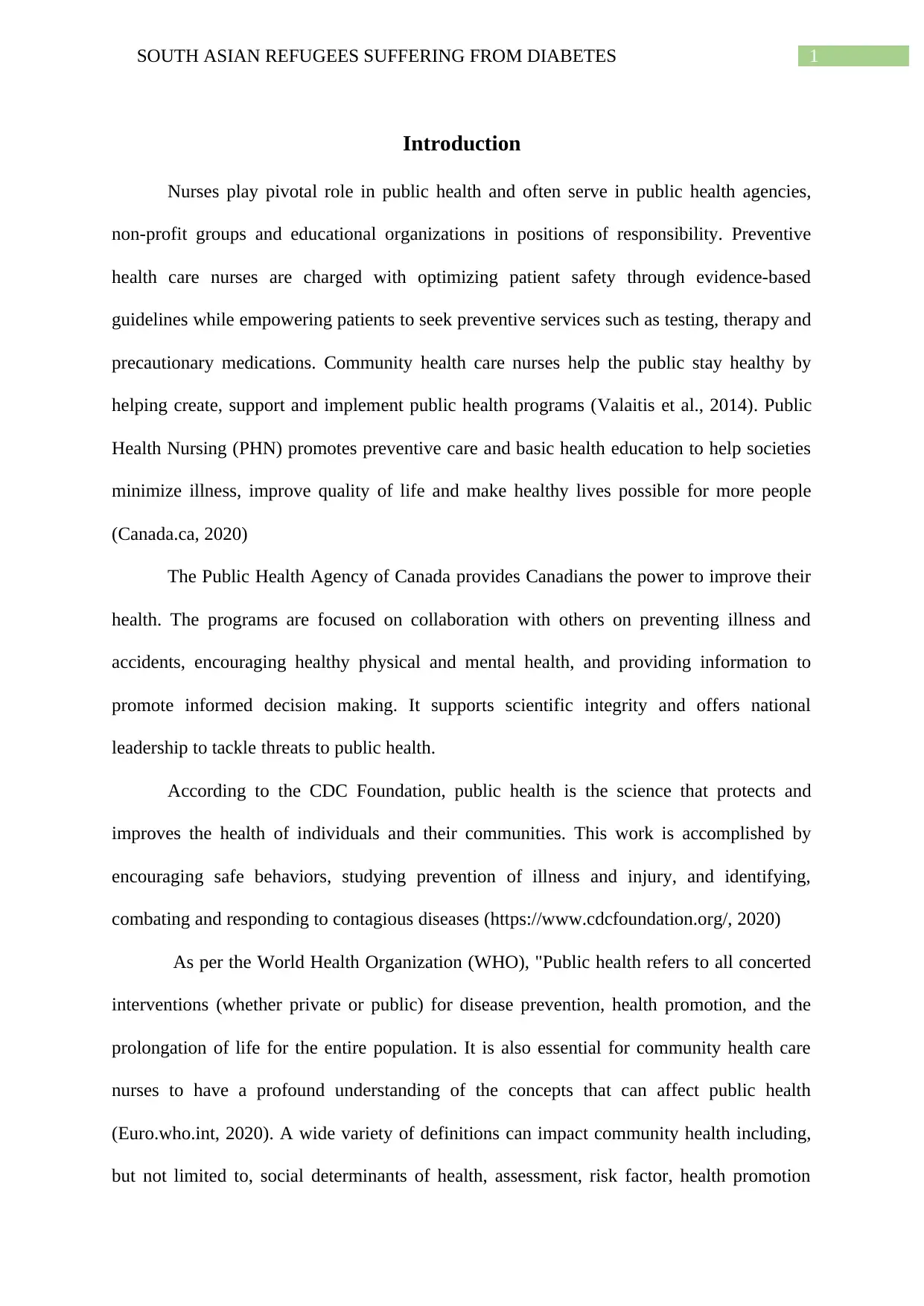
1SOUTH ASIAN REFUGEES SUFFERING FROM DIABETES
Introduction
Nurses play pivotal role in public health and often serve in public health agencies,
non-profit groups and educational organizations in positions of responsibility. Preventive
health care nurses are charged with optimizing patient safety through evidence-based
guidelines while empowering patients to seek preventive services such as testing, therapy and
precautionary medications. Community health care nurses help the public stay healthy by
helping create, support and implement public health programs (Valaitis et al., 2014). Public
Health Nursing (PHN) promotes preventive care and basic health education to help societies
minimize illness, improve quality of life and make healthy lives possible for more people
(Canada.ca, 2020)
The Public Health Agency of Canada provides Canadians the power to improve their
health. The programs are focused on collaboration with others on preventing illness and
accidents, encouraging healthy physical and mental health, and providing information to
promote informed decision making. It supports scientific integrity and offers national
leadership to tackle threats to public health.
According to the CDC Foundation, public health is the science that protects and
improves the health of individuals and their communities. This work is accomplished by
encouraging safe behaviors, studying prevention of illness and injury, and identifying,
combating and responding to contagious diseases (https://www.cdcfoundation.org/, 2020)
As per the World Health Organization (WHO), "Public health refers to all concerted
interventions (whether private or public) for disease prevention, health promotion, and the
prolongation of life for the entire population. It is also essential for community health care
nurses to have a profound understanding of the concepts that can affect public health
(Euro.who.int, 2020). A wide variety of definitions can impact community health including,
but not limited to, social determinants of health, assessment, risk factor, health promotion
Introduction
Nurses play pivotal role in public health and often serve in public health agencies,
non-profit groups and educational organizations in positions of responsibility. Preventive
health care nurses are charged with optimizing patient safety through evidence-based
guidelines while empowering patients to seek preventive services such as testing, therapy and
precautionary medications. Community health care nurses help the public stay healthy by
helping create, support and implement public health programs (Valaitis et al., 2014). Public
Health Nursing (PHN) promotes preventive care and basic health education to help societies
minimize illness, improve quality of life and make healthy lives possible for more people
(Canada.ca, 2020)
The Public Health Agency of Canada provides Canadians the power to improve their
health. The programs are focused on collaboration with others on preventing illness and
accidents, encouraging healthy physical and mental health, and providing information to
promote informed decision making. It supports scientific integrity and offers national
leadership to tackle threats to public health.
According to the CDC Foundation, public health is the science that protects and
improves the health of individuals and their communities. This work is accomplished by
encouraging safe behaviors, studying prevention of illness and injury, and identifying,
combating and responding to contagious diseases (https://www.cdcfoundation.org/, 2020)
As per the World Health Organization (WHO), "Public health refers to all concerted
interventions (whether private or public) for disease prevention, health promotion, and the
prolongation of life for the entire population. It is also essential for community health care
nurses to have a profound understanding of the concepts that can affect public health
(Euro.who.int, 2020). A wide variety of definitions can impact community health including,
but not limited to, social determinants of health, assessment, risk factor, health promotion
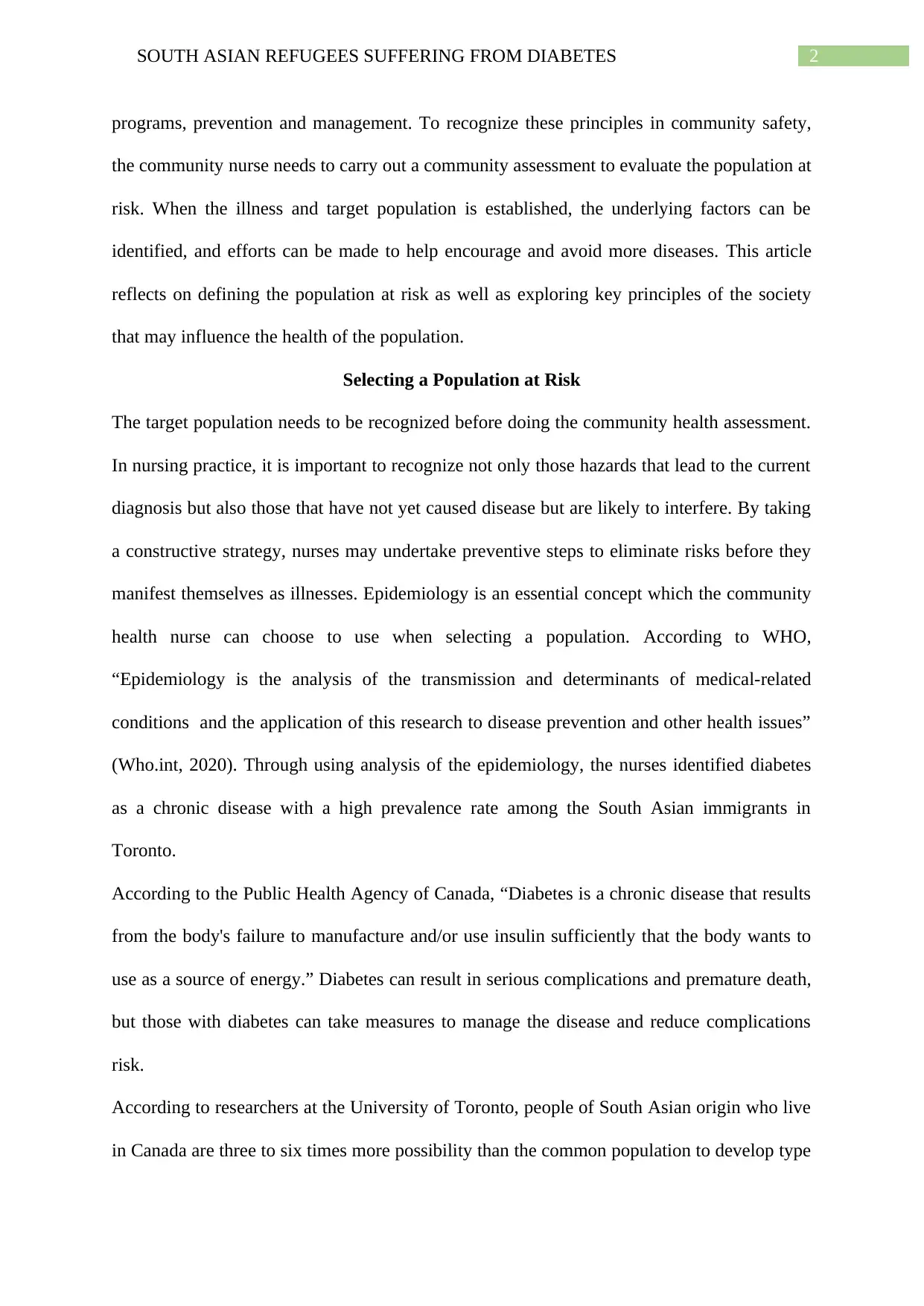
2SOUTH ASIAN REFUGEES SUFFERING FROM DIABETES
programs, prevention and management. To recognize these principles in community safety,
the community nurse needs to carry out a community assessment to evaluate the population at
risk. When the illness and target population is established, the underlying factors can be
identified, and efforts can be made to help encourage and avoid more diseases. This article
reflects on defining the population at risk as well as exploring key principles of the society
that may influence the health of the population.
Selecting a Population at Risk
The target population needs to be recognized before doing the community health assessment.
In nursing practice, it is important to recognize not only those hazards that lead to the current
diagnosis but also those that have not yet caused disease but are likely to interfere. By taking
a constructive strategy, nurses may undertake preventive steps to eliminate risks before they
manifest themselves as illnesses. Epidemiology is an essential concept which the community
health nurse can choose to use when selecting a population. According to WHO,
“Epidemiology is the analysis of the transmission and determinants of medical-related
conditions and the application of this research to disease prevention and other health issues”
(Who.int, 2020). Through using analysis of the epidemiology, the nurses identified diabetes
as a chronic disease with a high prevalence rate among the South Asian immigrants in
Toronto.
According to the Public Health Agency of Canada, “Diabetes is a chronic disease that results
from the body's failure to manufacture and/or use insulin sufficiently that the body wants to
use as a source of energy.” Diabetes can result in serious complications and premature death,
but those with diabetes can take measures to manage the disease and reduce complications
risk.
According to researchers at the University of Toronto, people of South Asian origin who live
in Canada are three to six times more possibility than the common population to develop type
programs, prevention and management. To recognize these principles in community safety,
the community nurse needs to carry out a community assessment to evaluate the population at
risk. When the illness and target population is established, the underlying factors can be
identified, and efforts can be made to help encourage and avoid more diseases. This article
reflects on defining the population at risk as well as exploring key principles of the society
that may influence the health of the population.
Selecting a Population at Risk
The target population needs to be recognized before doing the community health assessment.
In nursing practice, it is important to recognize not only those hazards that lead to the current
diagnosis but also those that have not yet caused disease but are likely to interfere. By taking
a constructive strategy, nurses may undertake preventive steps to eliminate risks before they
manifest themselves as illnesses. Epidemiology is an essential concept which the community
health nurse can choose to use when selecting a population. According to WHO,
“Epidemiology is the analysis of the transmission and determinants of medical-related
conditions and the application of this research to disease prevention and other health issues”
(Who.int, 2020). Through using analysis of the epidemiology, the nurses identified diabetes
as a chronic disease with a high prevalence rate among the South Asian immigrants in
Toronto.
According to the Public Health Agency of Canada, “Diabetes is a chronic disease that results
from the body's failure to manufacture and/or use insulin sufficiently that the body wants to
use as a source of energy.” Diabetes can result in serious complications and premature death,
but those with diabetes can take measures to manage the disease and reduce complications
risk.
According to researchers at the University of Toronto, people of South Asian origin who live
in Canada are three to six times more possibility than the common population to develop type
⊘ This is a preview!⊘
Do you want full access?
Subscribe today to unlock all pages.

Trusted by 1+ million students worldwide

3SOUTH ASIAN REFUGEES SUFFERING FROM DIABETES
2 diabetes. Individuals with type 2 diabetes will not always evolve with it, but usually
develop with an unhealthy lifestyle.
According to a study by Banerjee & Shah, (2018), it has been seen that for South Asian
migrants, the incidence of diabetes is high. Most previous work, however, has analyzed the
South Asians as a collective whole. This research aimed to investigate the prevalence of
diabetes among immigrants from five South Asian countries residing in Ontario, Canada. On
1 January 2012, immigration databases and population-based health care were used to
compare the prevalence of blunt and modified diabetes between immigrants to Ontario from
different South Asian countries and the non-immigrant population. There were 431,765 first-
generation South Asian immigrants, of whom 68,440 were diagnosed with diabetes (crude
prevalence of 15.9 percent). Despite standardization for age, income and sex, South Asians
had inflated prevalence of diabetes from Sri Lanka (26.8 percent) followed by Bangladesh
(22.2 percent), Pakistan (19.6 percent), India (18.3 percent) and Nepal (16.5 percent)
compared to the non-immigrants (11.6 percent). Remarkable variations in the prevalence of
diabetes are obvious among immigrants from various South Asian countries.
Social determinants of Health
The Canadian Association for Diabetes shows how Canadian health researchers and
politicians understand the value of various social determinants of public health. The factors
include lower socioeconomic status, negative belief and attitude, lifestyle changes, stress,
language and lack of support system. Diabetes and its causes do particularly affect people
with low socioeconomic status (SES). Lower SES is associated with several factors known to
lead to poor health outcomes among adults with diabetes, including decreased access to and
underuse of prescribed preventive treatment, impaired metabolic control and psychological
distress (Boonsatean et al., 2016). Psychological factors can affect the risk of acute and
2 diabetes. Individuals with type 2 diabetes will not always evolve with it, but usually
develop with an unhealthy lifestyle.
According to a study by Banerjee & Shah, (2018), it has been seen that for South Asian
migrants, the incidence of diabetes is high. Most previous work, however, has analyzed the
South Asians as a collective whole. This research aimed to investigate the prevalence of
diabetes among immigrants from five South Asian countries residing in Ontario, Canada. On
1 January 2012, immigration databases and population-based health care were used to
compare the prevalence of blunt and modified diabetes between immigrants to Ontario from
different South Asian countries and the non-immigrant population. There were 431,765 first-
generation South Asian immigrants, of whom 68,440 were diagnosed with diabetes (crude
prevalence of 15.9 percent). Despite standardization for age, income and sex, South Asians
had inflated prevalence of diabetes from Sri Lanka (26.8 percent) followed by Bangladesh
(22.2 percent), Pakistan (19.6 percent), India (18.3 percent) and Nepal (16.5 percent)
compared to the non-immigrants (11.6 percent). Remarkable variations in the prevalence of
diabetes are obvious among immigrants from various South Asian countries.
Social determinants of Health
The Canadian Association for Diabetes shows how Canadian health researchers and
politicians understand the value of various social determinants of public health. The factors
include lower socioeconomic status, negative belief and attitude, lifestyle changes, stress,
language and lack of support system. Diabetes and its causes do particularly affect people
with low socioeconomic status (SES). Lower SES is associated with several factors known to
lead to poor health outcomes among adults with diabetes, including decreased access to and
underuse of prescribed preventive treatment, impaired metabolic control and psychological
distress (Boonsatean et al., 2016). Psychological factors can affect the risk of acute and
Paraphrase This Document
Need a fresh take? Get an instant paraphrase of this document with our AI Paraphraser
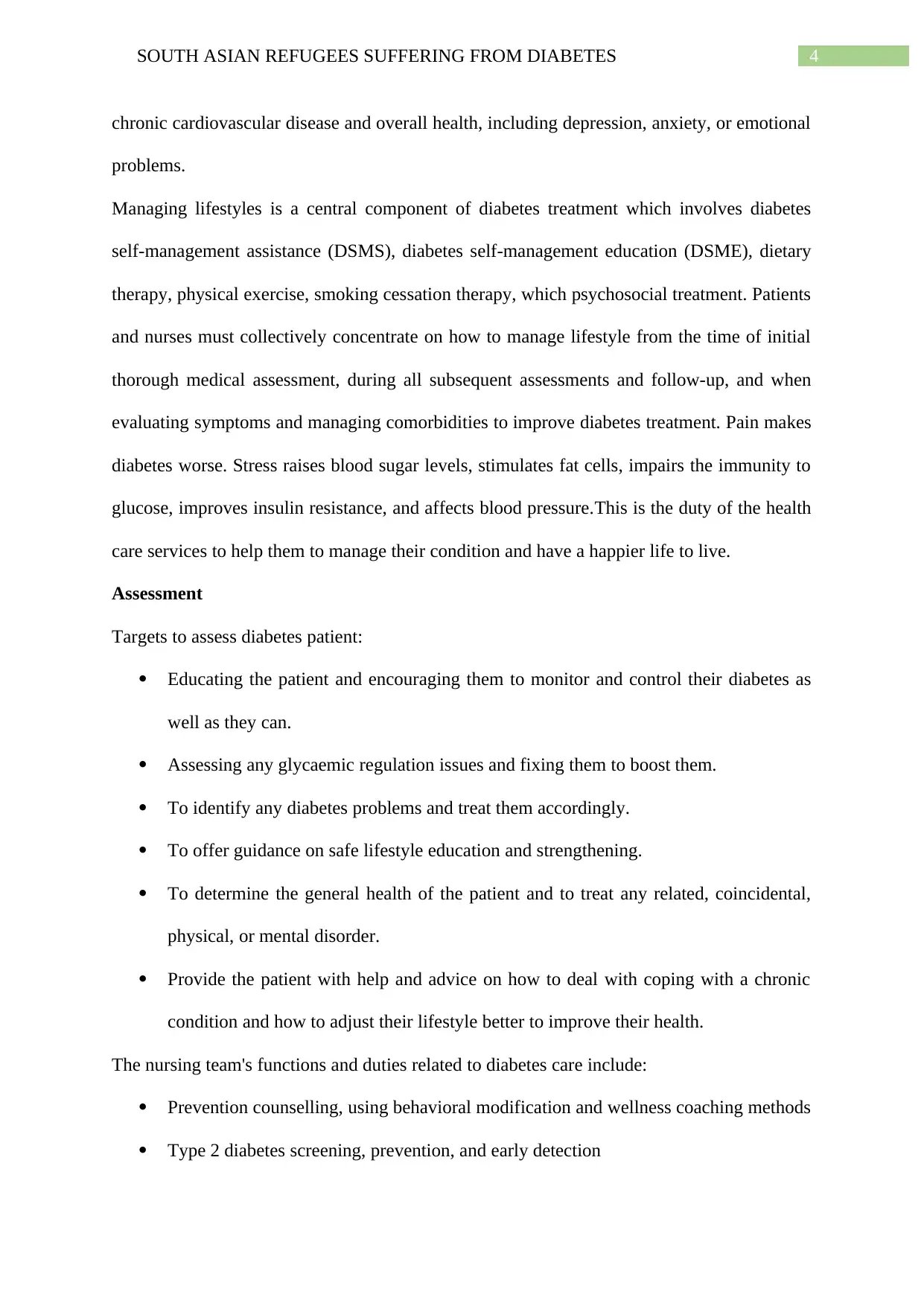
4SOUTH ASIAN REFUGEES SUFFERING FROM DIABETES
chronic cardiovascular disease and overall health, including depression, anxiety, or emotional
problems.
Managing lifestyles is a central component of diabetes treatment which involves diabetes
self-management assistance (DSMS), diabetes self-management education (DSME), dietary
therapy, physical exercise, smoking cessation therapy, which psychosocial treatment. Patients
and nurses must collectively concentrate on how to manage lifestyle from the time of initial
thorough medical assessment, during all subsequent assessments and follow-up, and when
evaluating symptoms and managing comorbidities to improve diabetes treatment. Pain makes
diabetes worse. Stress raises blood sugar levels, stimulates fat cells, impairs the immunity to
glucose, improves insulin resistance, and affects blood pressure.This is the duty of the health
care services to help them to manage their condition and have a happier life to live.
Assessment
Targets to assess diabetes patient:
Educating the patient and encouraging them to monitor and control their diabetes as
well as they can.
Assessing any glycaemic regulation issues and fixing them to boost them.
To identify any diabetes problems and treat them accordingly.
To offer guidance on safe lifestyle education and strengthening.
To determine the general health of the patient and to treat any related, coincidental,
physical, or mental disorder.
Provide the patient with help and advice on how to deal with coping with a chronic
condition and how to adjust their lifestyle better to improve their health.
The nursing team's functions and duties related to diabetes care include:
Prevention counselling, using behavioral modification and wellness coaching methods
Type 2 diabetes screening, prevention, and early detection
chronic cardiovascular disease and overall health, including depression, anxiety, or emotional
problems.
Managing lifestyles is a central component of diabetes treatment which involves diabetes
self-management assistance (DSMS), diabetes self-management education (DSME), dietary
therapy, physical exercise, smoking cessation therapy, which psychosocial treatment. Patients
and nurses must collectively concentrate on how to manage lifestyle from the time of initial
thorough medical assessment, during all subsequent assessments and follow-up, and when
evaluating symptoms and managing comorbidities to improve diabetes treatment. Pain makes
diabetes worse. Stress raises blood sugar levels, stimulates fat cells, impairs the immunity to
glucose, improves insulin resistance, and affects blood pressure.This is the duty of the health
care services to help them to manage their condition and have a happier life to live.
Assessment
Targets to assess diabetes patient:
Educating the patient and encouraging them to monitor and control their diabetes as
well as they can.
Assessing any glycaemic regulation issues and fixing them to boost them.
To identify any diabetes problems and treat them accordingly.
To offer guidance on safe lifestyle education and strengthening.
To determine the general health of the patient and to treat any related, coincidental,
physical, or mental disorder.
Provide the patient with help and advice on how to deal with coping with a chronic
condition and how to adjust their lifestyle better to improve their health.
The nursing team's functions and duties related to diabetes care include:
Prevention counselling, using behavioral modification and wellness coaching methods
Type 2 diabetes screening, prevention, and early detection

5SOUTH ASIAN REFUGEES SUFFERING FROM DIABETES
Encouraging self-care
Understanding the impact of mental health issues in diabetic people
Evaluating and meeting the dietary needs of the patient
Urine testing
Blood glucose testing
Oral therapies
Injectable therapies
Risk factor
Chronic complications that are associated with diabetes among the South Asian immigrants
in Toronto are:
Cardiovascular: Peripheral vascular disease, Heart disease, stroke
Eye: Cataracts, glaucoma, diabetic retinopathy,
Nerve damage: Neuropathy
Kidney damage: Nephropathy
Other risk factors that include are depression and stress. Stress may pose a major barrier
to the successful control of glucose. Stress hormones can influence glucose levels directly in
your body. People with type 2 diabetes are under mental stress, and their blood glucose levels
usually increase whereas physical stress affects type 1 or type 2 diabetes. The prevalence
levels of depression in patients with type 1 diabetes may be up to three times higher and
twice as high in people with type 2 diabetes as opposed to the general population. The nurses
can recommend those patients to take antidepressant medication, provide effective
psychotherapy, and help the patients to change the lifestyle of the patients (Petrak et al.,
2015)
Programs on Health promotion
Encouraging self-care
Understanding the impact of mental health issues in diabetic people
Evaluating and meeting the dietary needs of the patient
Urine testing
Blood glucose testing
Oral therapies
Injectable therapies
Risk factor
Chronic complications that are associated with diabetes among the South Asian immigrants
in Toronto are:
Cardiovascular: Peripheral vascular disease, Heart disease, stroke
Eye: Cataracts, glaucoma, diabetic retinopathy,
Nerve damage: Neuropathy
Kidney damage: Nephropathy
Other risk factors that include are depression and stress. Stress may pose a major barrier
to the successful control of glucose. Stress hormones can influence glucose levels directly in
your body. People with type 2 diabetes are under mental stress, and their blood glucose levels
usually increase whereas physical stress affects type 1 or type 2 diabetes. The prevalence
levels of depression in patients with type 1 diabetes may be up to three times higher and
twice as high in people with type 2 diabetes as opposed to the general population. The nurses
can recommend those patients to take antidepressant medication, provide effective
psychotherapy, and help the patients to change the lifestyle of the patients (Petrak et al.,
2015)
Programs on Health promotion
⊘ This is a preview!⊘
Do you want full access?
Subscribe today to unlock all pages.

Trusted by 1+ million students worldwide
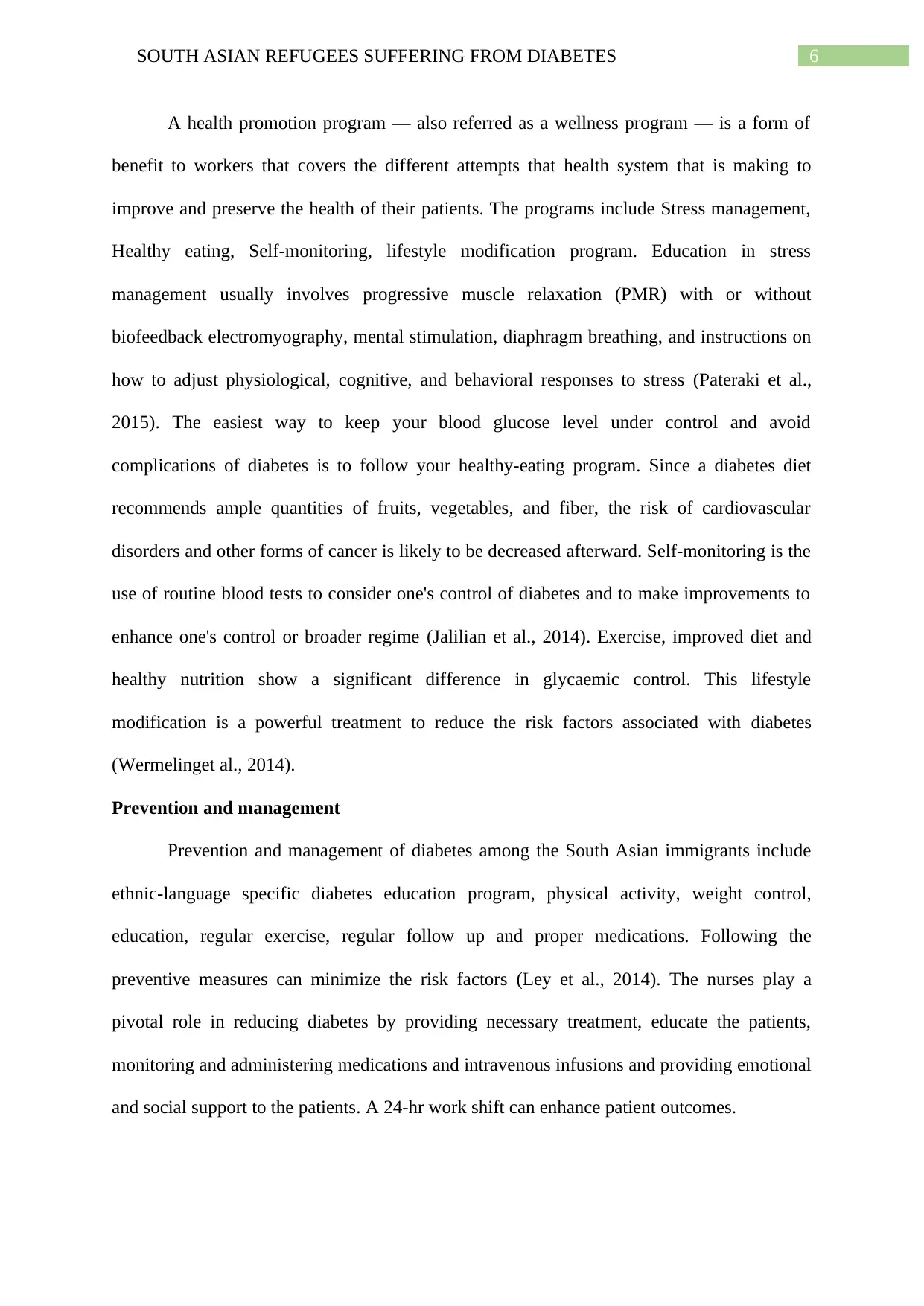
6SOUTH ASIAN REFUGEES SUFFERING FROM DIABETES
A health promotion program — also referred as a wellness program — is a form of
benefit to workers that covers the different attempts that health system that is making to
improve and preserve the health of their patients. The programs include Stress management,
Healthy eating, Self-monitoring, lifestyle modification program. Education in stress
management usually involves progressive muscle relaxation (PMR) with or without
biofeedback electromyography, mental stimulation, diaphragm breathing, and instructions on
how to adjust physiological, cognitive, and behavioral responses to stress (Pateraki et al.,
2015). The easiest way to keep your blood glucose level under control and avoid
complications of diabetes is to follow your healthy-eating program. Since a diabetes diet
recommends ample quantities of fruits, vegetables, and fiber, the risk of cardiovascular
disorders and other forms of cancer is likely to be decreased afterward. Self-monitoring is the
use of routine blood tests to consider one's control of diabetes and to make improvements to
enhance one's control or broader regime (Jalilian et al., 2014). Exercise, improved diet and
healthy nutrition show a significant difference in glycaemic control. This lifestyle
modification is a powerful treatment to reduce the risk factors associated with diabetes
(Wermelinget al., 2014).
Prevention and management
Prevention and management of diabetes among the South Asian immigrants include
ethnic-language specific diabetes education program, physical activity, weight control,
education, regular exercise, regular follow up and proper medications. Following the
preventive measures can minimize the risk factors (Ley et al., 2014). The nurses play a
pivotal role in reducing diabetes by providing necessary treatment, educate the patients,
monitoring and administering medications and intravenous infusions and providing emotional
and social support to the patients. A 24-hr work shift can enhance patient outcomes.
A health promotion program — also referred as a wellness program — is a form of
benefit to workers that covers the different attempts that health system that is making to
improve and preserve the health of their patients. The programs include Stress management,
Healthy eating, Self-monitoring, lifestyle modification program. Education in stress
management usually involves progressive muscle relaxation (PMR) with or without
biofeedback electromyography, mental stimulation, diaphragm breathing, and instructions on
how to adjust physiological, cognitive, and behavioral responses to stress (Pateraki et al.,
2015). The easiest way to keep your blood glucose level under control and avoid
complications of diabetes is to follow your healthy-eating program. Since a diabetes diet
recommends ample quantities of fruits, vegetables, and fiber, the risk of cardiovascular
disorders and other forms of cancer is likely to be decreased afterward. Self-monitoring is the
use of routine blood tests to consider one's control of diabetes and to make improvements to
enhance one's control or broader regime (Jalilian et al., 2014). Exercise, improved diet and
healthy nutrition show a significant difference in glycaemic control. This lifestyle
modification is a powerful treatment to reduce the risk factors associated with diabetes
(Wermelinget al., 2014).
Prevention and management
Prevention and management of diabetes among the South Asian immigrants include
ethnic-language specific diabetes education program, physical activity, weight control,
education, regular exercise, regular follow up and proper medications. Following the
preventive measures can minimize the risk factors (Ley et al., 2014). The nurses play a
pivotal role in reducing diabetes by providing necessary treatment, educate the patients,
monitoring and administering medications and intravenous infusions and providing emotional
and social support to the patients. A 24-hr work shift can enhance patient outcomes.
Paraphrase This Document
Need a fresh take? Get an instant paraphrase of this document with our AI Paraphraser

7SOUTH ASIAN REFUGEES SUFFERING FROM DIABETES
Conclusion
From this assignment, it can be concluded that the prevalence of type 2 diabetes is
high for the targeted population. The chosen community in this assignment is South Asian
immigrants in Toronto. Five community health concepts have been selected and an in-depth
discussion has been provided. The health concepts include social determinants of health, risk
factors associated with diabetes, health promotion programs, assessment of diabetes and
prevention, and management of diabetes. The role of nurses and evidence based practice has
been articulated in community health concepts.
Conclusion
From this assignment, it can be concluded that the prevalence of type 2 diabetes is
high for the targeted population. The chosen community in this assignment is South Asian
immigrants in Toronto. Five community health concepts have been selected and an in-depth
discussion has been provided. The health concepts include social determinants of health, risk
factors associated with diabetes, health promotion programs, assessment of diabetes and
prevention, and management of diabetes. The role of nurses and evidence based practice has
been articulated in community health concepts.
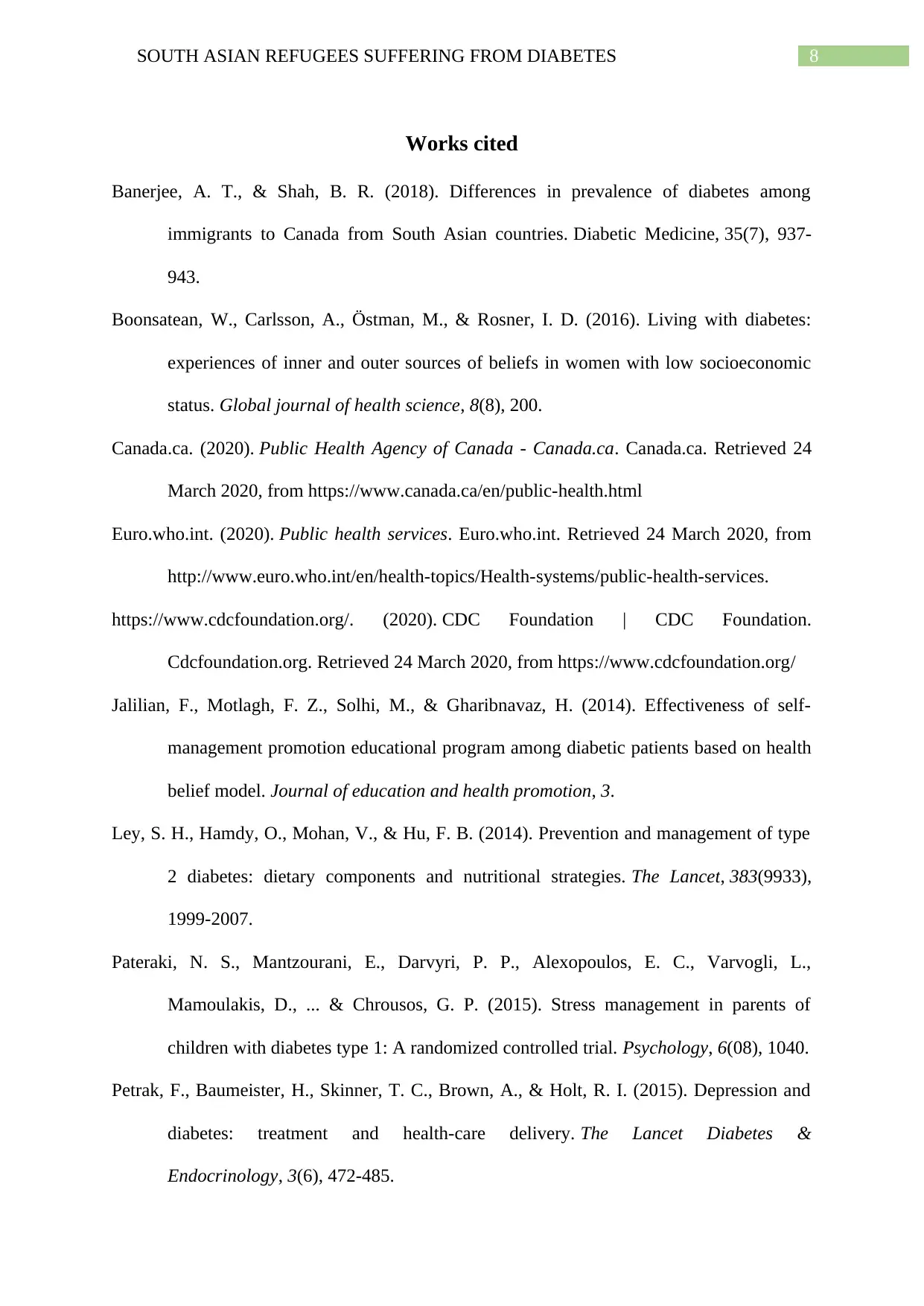
8SOUTH ASIAN REFUGEES SUFFERING FROM DIABETES
Works cited
Banerjee, A. T., & Shah, B. R. (2018). Differences in prevalence of diabetes among
immigrants to Canada from South Asian countries. Diabetic Medicine, 35(7), 937-
943.
Boonsatean, W., Carlsson, A., Östman, M., & Rosner, I. D. (2016). Living with diabetes:
experiences of inner and outer sources of beliefs in women with low socioeconomic
status. Global journal of health science, 8(8), 200.
Canada.ca. (2020). Public Health Agency of Canada - Canada.ca. Canada.ca. Retrieved 24
March 2020, from https://www.canada.ca/en/public-health.html
Euro.who.int. (2020). Public health services. Euro.who.int. Retrieved 24 March 2020, from
http://www.euro.who.int/en/health-topics/Health-systems/public-health-services.
https://www.cdcfoundation.org/. (2020). CDC Foundation | CDC Foundation.
Cdcfoundation.org. Retrieved 24 March 2020, from https://www.cdcfoundation.org/
Jalilian, F., Motlagh, F. Z., Solhi, M., & Gharibnavaz, H. (2014). Effectiveness of self-
management promotion educational program among diabetic patients based on health
belief model. Journal of education and health promotion, 3.
Ley, S. H., Hamdy, O., Mohan, V., & Hu, F. B. (2014). Prevention and management of type
2 diabetes: dietary components and nutritional strategies. The Lancet, 383(9933),
1999-2007.
Pateraki, N. S., Mantzourani, E., Darvyri, P. P., Alexopoulos, E. C., Varvogli, L.,
Mamoulakis, D., ... & Chrousos, G. P. (2015). Stress management in parents of
children with diabetes type 1: A randomized controlled trial. Psychology, 6(08), 1040.
Petrak, F., Baumeister, H., Skinner, T. C., Brown, A., & Holt, R. I. (2015). Depression and
diabetes: treatment and health-care delivery. The Lancet Diabetes &
Endocrinology, 3(6), 472-485.
Works cited
Banerjee, A. T., & Shah, B. R. (2018). Differences in prevalence of diabetes among
immigrants to Canada from South Asian countries. Diabetic Medicine, 35(7), 937-
943.
Boonsatean, W., Carlsson, A., Östman, M., & Rosner, I. D. (2016). Living with diabetes:
experiences of inner and outer sources of beliefs in women with low socioeconomic
status. Global journal of health science, 8(8), 200.
Canada.ca. (2020). Public Health Agency of Canada - Canada.ca. Canada.ca. Retrieved 24
March 2020, from https://www.canada.ca/en/public-health.html
Euro.who.int. (2020). Public health services. Euro.who.int. Retrieved 24 March 2020, from
http://www.euro.who.int/en/health-topics/Health-systems/public-health-services.
https://www.cdcfoundation.org/. (2020). CDC Foundation | CDC Foundation.
Cdcfoundation.org. Retrieved 24 March 2020, from https://www.cdcfoundation.org/
Jalilian, F., Motlagh, F. Z., Solhi, M., & Gharibnavaz, H. (2014). Effectiveness of self-
management promotion educational program among diabetic patients based on health
belief model. Journal of education and health promotion, 3.
Ley, S. H., Hamdy, O., Mohan, V., & Hu, F. B. (2014). Prevention and management of type
2 diabetes: dietary components and nutritional strategies. The Lancet, 383(9933),
1999-2007.
Pateraki, N. S., Mantzourani, E., Darvyri, P. P., Alexopoulos, E. C., Varvogli, L.,
Mamoulakis, D., ... & Chrousos, G. P. (2015). Stress management in parents of
children with diabetes type 1: A randomized controlled trial. Psychology, 6(08), 1040.
Petrak, F., Baumeister, H., Skinner, T. C., Brown, A., & Holt, R. I. (2015). Depression and
diabetes: treatment and health-care delivery. The Lancet Diabetes &
Endocrinology, 3(6), 472-485.
⊘ This is a preview!⊘
Do you want full access?
Subscribe today to unlock all pages.

Trusted by 1+ million students worldwide

9SOUTH ASIAN REFUGEES SUFFERING FROM DIABETES
Valaitis, R. K., Schofield, R., Akhtar-Danesh, N., Baumann, A., Martin-Misener, R.,
Underwood, J., & Isaacs, S. (2014). Community health nurses’ learning needs in
relation to the Canadian community health nursing standards of practice: results from
a Canadian survey. BMC nursing, 13(1), 31.
Wermeling, M., Thiele-Manjali, U., Koschack, J., Lucius-Hoene, G., & Himmel, W. (2014).
Type 2 diabetes patients’ perspectives on lifestyle counselling and weight
management in general practice: a qualitative study. BMC family practice, 15(1), 97.
Who.int. (2020). WHO | Epidemiology. Who.int. Retrieved 24 March 2020, from
https://www.who.int/topics/epidemiology/en/
Valaitis, R. K., Schofield, R., Akhtar-Danesh, N., Baumann, A., Martin-Misener, R.,
Underwood, J., & Isaacs, S. (2014). Community health nurses’ learning needs in
relation to the Canadian community health nursing standards of practice: results from
a Canadian survey. BMC nursing, 13(1), 31.
Wermeling, M., Thiele-Manjali, U., Koschack, J., Lucius-Hoene, G., & Himmel, W. (2014).
Type 2 diabetes patients’ perspectives on lifestyle counselling and weight
management in general practice: a qualitative study. BMC family practice, 15(1), 97.
Who.int. (2020). WHO | Epidemiology. Who.int. Retrieved 24 March 2020, from
https://www.who.int/topics/epidemiology/en/
1 out of 10
Related Documents
Your All-in-One AI-Powered Toolkit for Academic Success.
+13062052269
info@desklib.com
Available 24*7 on WhatsApp / Email
![[object Object]](/_next/static/media/star-bottom.7253800d.svg)
Unlock your academic potential
Copyright © 2020–2025 A2Z Services. All Rights Reserved. Developed and managed by ZUCOL.





